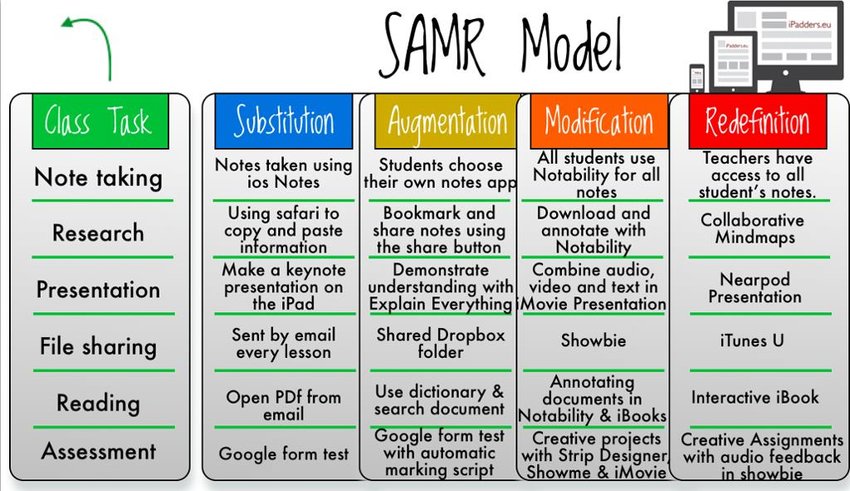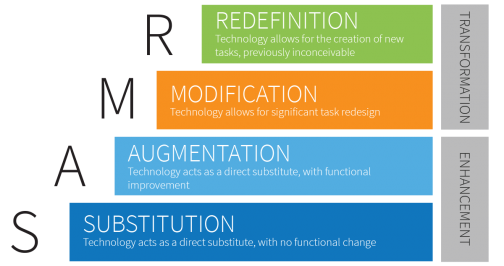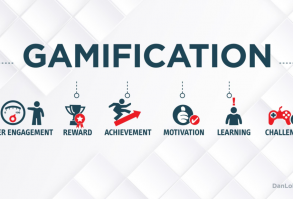‘Internet Generation’ calls for a more innovative and digital learning environment. Without considering this, designing a lesson evidently would not lead successful learning. This belief is getting more popular between educators as they realize the characteristics of 21st century learners. Most of them strive for integrating technology into classes and curriculum however, there is a need to measure and improve the quality of integration rather than using solely for “tech for tech’s sake”.
The SAMR (Substitution, Augmentation, Modification, Redefinition) model was developed by Dr. Ruben Puentedura as a framework to demonstrate the effects of technology on teaching and learning. The SAMR model is a tool for “…assessing and evaluating technology practices and impacts in the classroom setting” and can be examined at both the student and teachers levels (Bada, & Kalegele, 2016, p.108). It allows teachers to interpret the levels (Lacruz, 2018). The figure above illustrates and defines the model as a hierarchical from substitution to redefinition.
The SAMR Model: Four steps in designing the task
Substitution is described as the first stage of integration in a classroom in which technology acts as a direct replacement of older equipment. For instance, students take notes on computer instead of notebooks. While this is only the beginning step, many teachers are staying at this phase.
Augmentation is the second stage in which functional improvement begins with the substitution in learning. For example, students can change or modify their essay in the word with different tools. This kind of functional improvements enhance the students’ learning experience and augments productivity.
Modification is the third stage where move from enhancement to transformation begins. In this stage, there is a shift in the lesson design and fundamentally redesign it with technology, which impacts the quality of learning outcome. To be able to understand whether the transformation begins, we should ask “Does the technology considerably change the task?”. For example, students may add pictures or links to their essays written in the word.
Redefinition is the last stage of the model where technology entirely transforms the students’ experience. Technology provides opportunities to redefine and redesign a traditional task. The redefined task cannot be created without technology. In this stage, technology integration fosters and transform the lesson in a way that promotes creativity, productivity and collaboration.
It is important to note that the one on the top does not necessarily mean the best practice of all since they have different kinds of uses. However, students’ involvement and motivation is rising with the technology integration particularly at modification and redefinition stages. The figure 2 illustrates the SAMR Model in different levels. It can be understood from the figures how the tasks evolve with the technology.

Bloom’s Taxonomy and SAMR Model
Bloom’s Taxonomy is described as a pedagogical model of cognitive skills in order to set up learning experiences that take students from lower-order to higher-order tasks. With the revision by Anderson and Krawthol (2000), each level is defined by action verbs such as remember, understand, apply, analyze, evaluate and create instead of nouns. Andrew Churches improved the model by matching cognitive skills to technology application to determine and evaluate activities with digital tools.
‘Redifinition’ stage in SAMR makes it possible for learners to activate their higher cognitive skills however, there is no direct relationship between the two taxonomies. It depends on the teachers’ productivity in designing the lesson. For example, Nearpod as presentation tool has a great potential to design collaborative and interactive lessons but, it can also be used only for activities that demand remembering and understanding.

Visit the websites below for in-depth analysis of the model:
– Google Apps with the SAMR Model
– Integration Technology (SAMR)
– How to Apply the SAMR Model with Ruben Puentedura
Please feel free to contact me if you need any further information.
References
Anderson, L.W., and D. Krathwohl (Eds.) (2001). A Taxonomy for Learning, Teaching and Assessing: a Revision of Bloom’s Taxonomy of Educational Objectives. Longman, New York.
Churches, A. (2009) Bloom’s Digital Taxonomy.
Kihoza, P., Zlotnikova, I., Bada, J., & Kalegele, K. (2016). Classroom ICT integration in Tanzania: Opportunities and challenges from the perspectives of TPACK and SAMR models. International Journal of Education and Development using ICT, 12(1).
Lacruz, N. (2018). SAMR Model. Technology and the Curriculum: Summer 2018.
Puentedura, R. (2006). Transformation, technology, and education.






